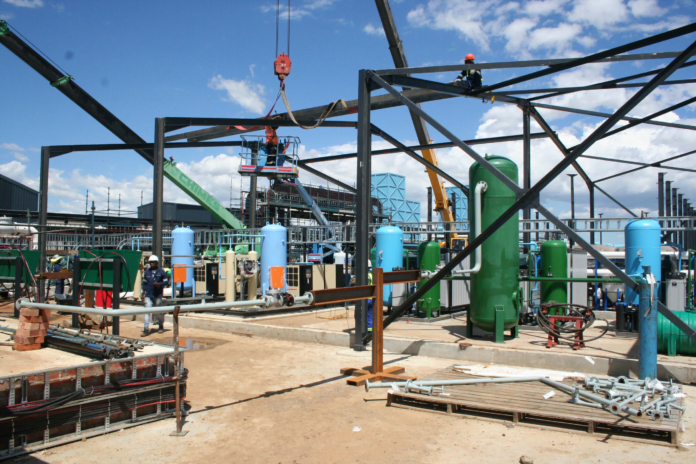DESPITE the jewel in the crown of Renengen’s Virginia Gas Project being the much sought after helium, its cryogenic pilot plant is expected to come into full commercial operation supplying Liquefied Natural Gas (LNG) and helium in April this year.
In an exclusive interview with CBN, CEO Stefano Marani explained that the company had already secured LNG supply agreements with Consol Glass and Italtile, which would be fulfilled to customers via a “virtual pipeline” – trucked ISO containers, maintained at -162⁰C, the temperature where the methane gas turns into a liquid.
“The pilot plant has a daily output of 2 500 GJ of gas and 350 kg of helium which will be ramped up with a more substantial plant in Phase 2, once pending financial arrangements have been secured” he said.
The 187 ha Virginia site has been conservatively estimated to yield more than 400 000 PJ (Petajoules) of methane gas and to bring that into some perspective South Africa’s current total natural gas consumption is 180 PJ per annum, currently supplied by the diminishing Pande-Temane gas fields in Mozambique via the ROMPCO pipeline, the only source of supply.
“As all of the gas demand is located in Gauteng (50 PJ), Mpumalanga (110 PJ) and KwaZulu-Natal (KZN) (20 PJ), is supplied from the ROMPCO pipeline and from Sasol operations, the rest of the country has little or no access to LNG until now, and that is the market opportunity we see” explained Marani.
He says that while a pipeline to the country’s other major centres would at first sight appear to be the obvious method of transportation of LNG, NERSA’s punitive regulations, cost, legal and environmental concerns makes the mobile concept a feasible option.
Until the country’s collapsed rail system is rejuvenated, non-existent port and rail LNG terminals are completed, road transportation is the only option to meet the anticipated demand.
At long last the realisation of LNG as an essential part of the country’s energy mix has been realised following the publication of the Integrated Resource Plan which aims to increase the contribution of natural gas from the current 2.6% to 15.7% by 2030.
That is less than eight years away and begs the question as to how the country’s dilapidated transport system – especially rail – can be brought up to meeting the challenge, not only from Renergen’s gas fields in Virginia, but from the off-shore finds such as the Brulpadda Block via Petro SA’s Mossel Bay facility.
Gas Plan sketches potential
The 2022 Gas Master Plan Consultation Document paints a rosy picture of the potential of gas, anticipating that power generation (57%) and industry (37%) will account for nearly 95% of the gas market.
It states “The existing Open Cycle Gas Turbine (OCGT) peaking plants present and ideal opportunity for conversion to natural gas, with the potential to realise substantial cost savings of more than 30% from a fuel source (currently diesel) perspective.” Nationally there are six OCGT plants in operation with a combined capacity of nearly 4 GW which if converted to run on natural gas would not only be a cheaper and cleaner alternative to diesel but would also result in a potentially higher energy output.
While the report identifies further opportunities in converting mothballed coal fired power plants to run on natural gas, re-purposing existing infrastructure, Renergen’s Marani is less optimistic. “The age and state of dilapidation of many of the country’s coal fired stations is so far gone that it will most probably be cheaper to start from scratch and build a new plant where it is needed – not on adjacent coal field” he argues.
The RMIPPP (Risk Mitigation Independent Power Producer Procurement Programme) 2020, opened the door not only for solar and wind renewables but also for natural gas fired plants as a short term measure to alleviate our critical shortage of Eskom power, no doubt as a response to the enormous cost of importing diesel to drive the, now essential, OCGT’s.
The recent statement by Cape Town’s Mayor Geordin Hill-Lewis, that the City intends to become the only South African city that will be immune to loadshedding, by entering into a supply contract with an independent power producer to supply 300 MW of sustainable power to the City, seems to present an opportunity for natural gas suppliers such as Renergen, but then there’s the question of transportation…
